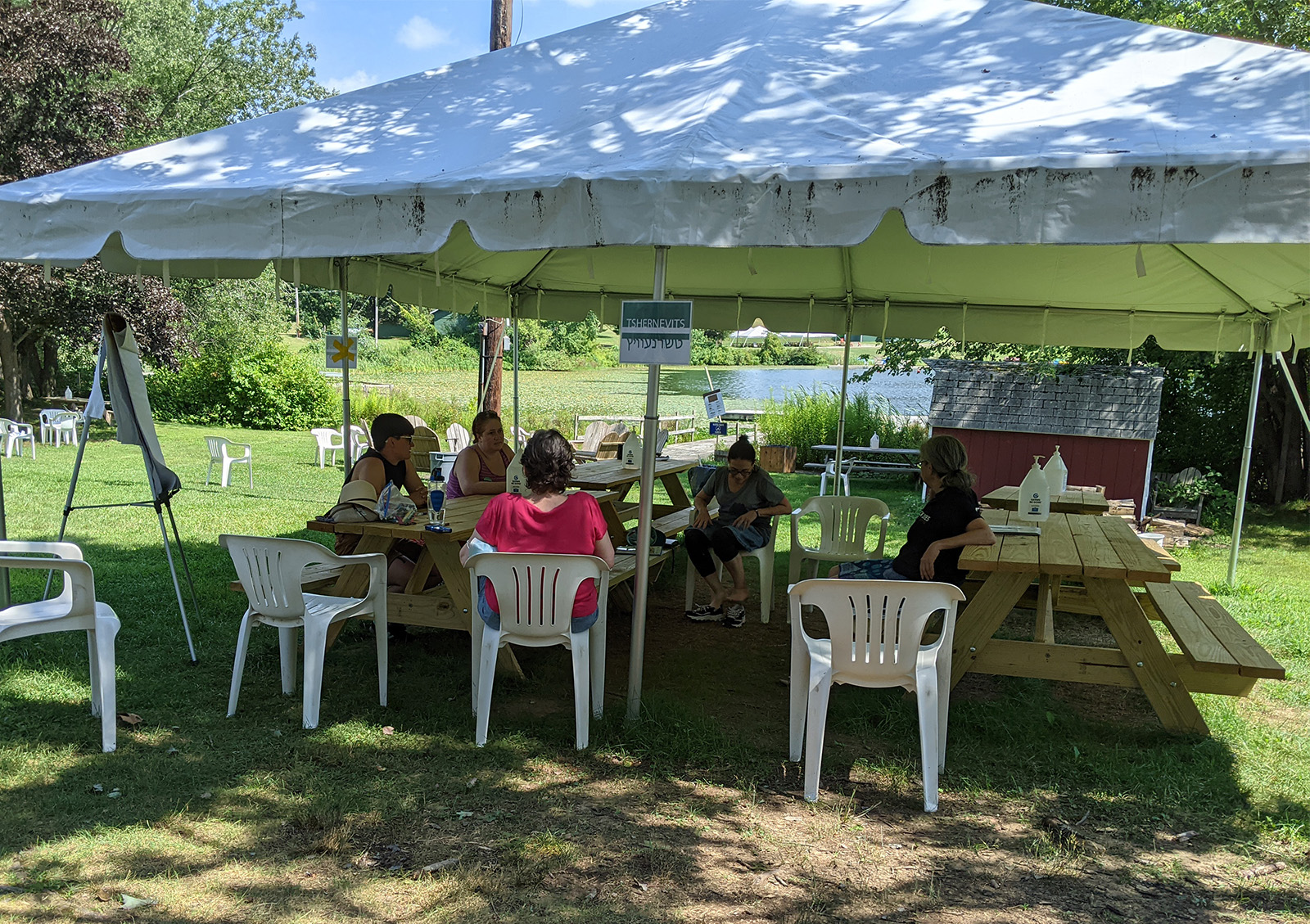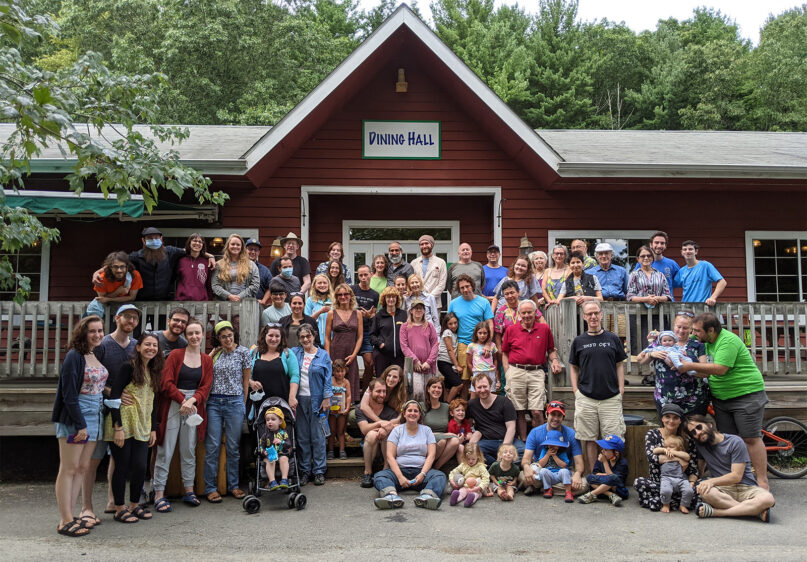(RNS) — The grounds of the Berkshire Hills Eisenberg Camp in Copake, New York, were alive in mid-August with a gaggle of nearly 100 campers, young and old.
Like at many camps in upstate New York, they played sports, boated in the lake, swam in the pool and sang songs around the campfire.
However, to them it wasn’t a lake, it was an ozere, the cabins were not cabins, but beydlekh, and the pool, der shvimbaseyn.
The reason is that they were there with a singular purpose — to swim, sing, eat and simply live solely in Yiddish, the historical language of Ashkenazi Jewry.
RELATED: How Orthodox Jews became a streaming-TV hit
Yiddish-Vokh (Yiddish-week) has been an annual celebration of the tongue since 1975, when it was founded by Yugntruf, an organization that promotes the use of Yiddish among young people and families.
A mix of Old High German with Hebrew, Aramaic and Slavic components, Yiddish had more than 11 million speakers by the late 1930s. Most lived in Eastern Europe.
In its heyday, Yiddish was not just a language of religion, but of all aspects of life, including science, agriculture, literature and certainly politics.
“For the vast majority of Jews in Eastern Europe, Yiddish was their lingua franca for a thousand years,” explained Rukhl Schaechter, editor of the Yiddish Forward. Founded in 1897, it is America’s longest-running Yiddish newspaper. “Out of it came a rich Yiddish literature of novels, poetry, folk songs, Hasidic parables, plays, films and countless clever and often humorous aphorisms.“
The Holocaust more than halved that number of speakers, while assimilation in America, Hebraicism in Israel and cultural repression in the Soviet Union further whittled it down among survivors.
Though it is not considered an endangered language today, generous estimates posit barely 500,000 speakers worldwide.
The overwhelming majority of speakers are ultra-Orthodox Jews, whose high birthrates are largely to thank for pulling the language from the brink of extinction.
However, frock coats, long side curls and wide-brimmed hats were largely absent from the camp. That’s because the program is mostly attended by those who don’t have a large Yiddish-speaking community to interact with during the rest of the year.

Yiddish-Vokh campers attend a class at Berkshire Hills Eisenberg Camp in Copake, New York, Aug. 13, 2021. Photo courtesy of Yugntruf
This year, amid the pandemic, the program had a relatively low turnout of 90 participants, but on an average year it draws anywhere from 120 to 160.
They include everyone from non-Jews to secular Jews, as well as Reform, Conservative and Orthodox Jews ranging in age from infants to nearly 90.
Their reasons for coming to the language are broad and varied.
“I don’t think there is a single reason. It’s different for every member,” said Jordan Kutzik, the chairman of Yugntruf.
For some, Yiddish provides a connection to the lost world of their grandparents and other ancestors. For others it’s an avenue to connect with Jewish culture in a way that modern Hebrew doesn’t. Others still are simply polyglots, enamored of the language’s unique history and rich literary body.
For Schaechter, whose father, the late Professor Mordkhe Schaechter, founded the program, and who has been attending since 1977, Yiddish is also an act of remembrance for the lost culture of the overwhelming majority of the Holocaust’s victims.
For all the campers, the week is refuge from a world that too often doesn’t understand their devotion to a language that even many Jews view as archaic.
“People don’t really appreciate what we’re doing, so that makes us feel a stronger bond to each other,” Schaechter said.
Formerly, there was another motivation for those who attended Yiddish-Vokh. “It really started out as a singles event,” Schaechter recalled. “In fact, I first went to find a Yiddish-speaking guy.”
“It’s nice to have a romance in Yiddish,” she added.
But many of the couples formed at Yiddish-Vokh never stopped coming, instead bringing their families, and the program became a place for Yiddish-speaking children to meet each other as well.
Yugntruf’s treasurer, Meena-Lifshe Viswanath, is such a child of Yiddish-Vokh.
The daughter of a couple who met at the program in 1985, Viswanath, 32, has been attending Yiddish-Vokh her entire life and now brings her children to the event. They’re the fourth generation in her family to be involved in the program, as she also happens to be a granddaughter of Mordkhe Schaechter (and Rukhl’s niece).

Campers participate in Yiddish-Vokh at Berkshire Hills Eisenberg Camp in Copake, New York, Aug. 13, 2021. Photo courtesy of Yugntruf
When she was a child, Viswanath recalls, Yiddish-Vokh was the highlight of her year, but only as a parent did she realize how important it really is for inculcating a love of the Yiddish language in her children.
“One thing which is really difficult for speakers of a minority language, especially a minority language which isn’t geographically concentrated in one particular place, is that if you don’t have anyone to speak with, it is really hard to keep that up,” explained Viswanath, who lives in Maryland.
The closest Yiddish-speaking peer her 6-year-old son has is more than an hour’s drive away.
“It’s a fairly common issue for children who speak minority languages. If they don’t see anybody around speaking their language as they grow up, they’ll kind of drift away from it,” she said.
Coming to Yiddish-Vokh, however, gives him an opportunity to meet and make friends with other Yiddish speakers his age.
“It’s really important for children to see that they have peers who speak Yiddish,” she said. “I know that personally, as I was growing up, Yiddish-Vokh was very formative in my decision to stick with Yiddish, because I had this community that came together every year.”
Also, her aunt Rukhl added, “For us it’s like a family reunion.” Some 27 members of the Schaechter clan attended the event this year.
And they’re not the only ones.
Paula Teitelbaum, a teacher of Yiddish for the Workers Circle, attended the program with two other generations of her family. She met the father of her children there as well.
Her children have also managed to make lifelong friends at Yiddish-Vokh.
According to Viswanath, the presence of extended families like Teitelbaum’s and the Schaechters also serves to inspire younger attendees that family life in Yiddish outside of an ultra-Orthodox context really is something possible.
“Sometimes students learning (Yiddish) in college will come, and they’ll see families with kids being raised in Yiddish, and that really gives people the reinforcement to keep on with it,” Viswanath said. “People learn all kinds of languages at some point in their life, and don’t necessarily stick with it. But for people who learn Yiddish it really helps to see that there is this whole community.”
So while the demographics of the Yiddish-speaking world change, Yiddish-Vokh doesn’t look as if it’s going anywhere anytime soon.
“I think it’s in a really steady state,” Kutzik said. “We have fewer Holocaust survivors every year, which is sad. But, you know, we have a younger generation, Generation Z, and I don’t even know what the Generation after Generation Z is going to be called, but they’re the 1- and 2-year-olds who are already coming now.”





